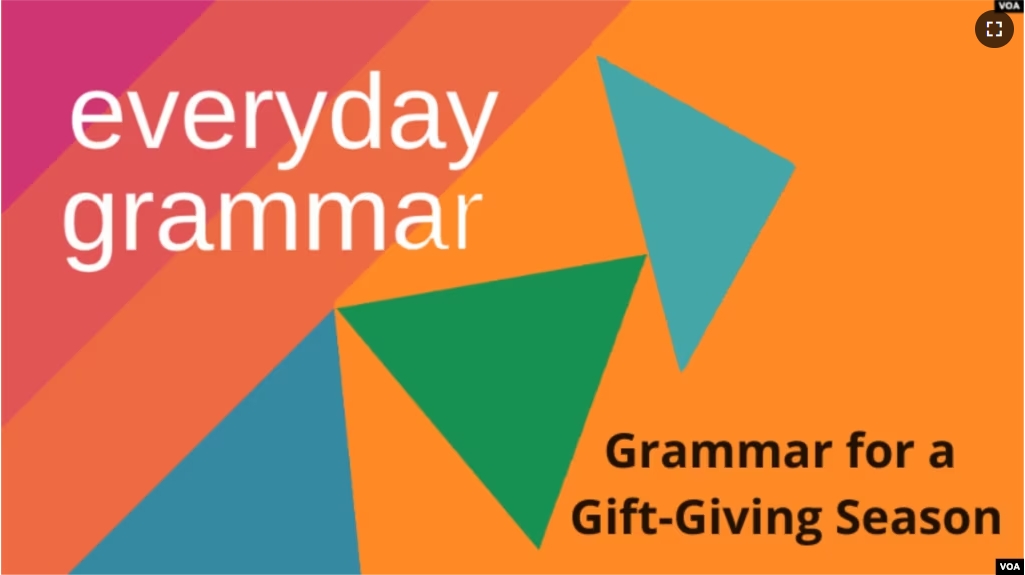We are entering a major gift-giving season in the United States. People purchase goods and services for their loved ones, friends, coworkers, and others.
But how do we talk about giving gifts? How do we use subjects, verbs, and objects to describe gift giving?
Those questions will be the subject of today’s Everyday Grammar.
Let’s start with some important terms and ideas.
Elements
In a recent Everyday Grammar lesson, we explored questions about gifts – asking what others might want in terms of a gift.
In today’s lesson, we will talk about statements we might make after we purchase the gift.
Before we continue with the lesson, we need to identify the key elements of a sentence.
The simplest way to divide a sentence is into two parts: the subject and the predicate.
The subject is generally a noun, noun phrase, or pronoun.
The predicate, on the other hand, says something about the subject. The predicate contains a verb, objects, indirect objects, and so on.
Now that we have our basic building blocks of language, we should explore how to put them together.
Putting elements together
We will start with the predicate. Why? Because the predicate is central to today’s lesson.
The language we use in the predicate to describe a gift purchase often falls into a simple pattern: transitive verb + noun phrase 1+noun phrase 2.
A transitive verb is one that takes a direct object. A direct object is the receiver of the verb’s action.
So, in the pattern we just learned about, we can say that the transitive verb takes a noun phrase that acts like the direct object.
Finally, we might have a second noun phrase that acts like the indirect object – the person who receives the direct object.
Please note that the direct object does not always appear directly next to the verb, as we will see.
Some examples will clarify this explanation.
Examples
When we talk about gift giving, we often use three transitive verbs: get, buy, and give.
The direct object is the gift. The indirect object is the person receiving the gift.
So, let’s imagine we have a friend named Mary. We might say the following about Mary’s gift-giving decision:
Mary got her son a book.
In our example, the subject is Mary. The predicate is “got her son a book.”
The direct object is “a book.” What did Mary get? She got a book. Who is going to receive the book? Her son. In this case, “her son” is the indirect object.
So, in the sentence “Mary got her son a book,” we can say that the structure is subject + transitive verb + noun phrase 1 + noun phrase 2.
Here are two other examples. Let’s use the transitive verbs “buy” and “give”:
Jonathan bought his mother a sweater.
Felicia gave her friend a painting.
All of these examples are in their past forms. But we can also use these verbs in other forms as well.
Practice
Let’s take some time to work with these ideas. Create a sentence using the following elements:
The subject is “My father.”
The predicate consists of the verb “get,” the noun phrase “a vase,” and the noun phrase “my mother.”
Pause the audio to consider your answer.
Here is one possible answer:
My father got my mother a vase.
The order of the sentence is subject + transitive verb + indirect object + direct object.
Closing thoughts
Today we explored one pattern we often use to describe gift giving. To be clear: we use other patterns as well.
One of these makes use of the prepositions “to” and “for.” But that will have to be the subject of a future lesson.
I’m John Russell.
John Russell wrote this lesson for VOA Learning English.
_____________________________________________
Words in This Story
predicate – n. grammar: the part of a sentence that expresses what is said about the subject
pattern – n. the regular and repeated way in which something happens
phrase – n. a group of two or more words that express a single idea but do not usually form a complete sentence
vase – n. a container that is used for holding flowers or for decoration
